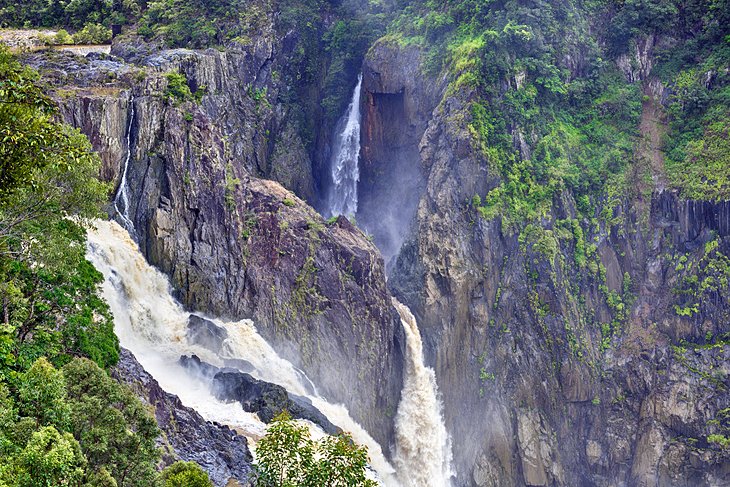Barron-Gorge-Nationalpark
The Barron Gorge National Park (English: Barron Gorge National Park ) is a national park in northeastern Australian state of Queensland. It is located 404 km north-west of Brisbane, about 14 km north-west of Cairns and 2 km south-east of Kuranda. The park is part of the Wet Tropics of Queensland. The Kuranda Scenic Railway runs through the park and has a railway station on the Barron Falls. Daily once a train in each direction to and from Cairns. The old weir of 1934 from the upper end of the falls can be seen from the vantage point at the station.
Landforms
The Barron Gorge was created where the Barron River cascades down over the eastern rocky steps of the Atherton Tablelands. The Barron Falls form a 25 m high cascade down to the bottom of the canyon. Two waterfalls - the Stoney Cteek case and the Surprise Creek Falls - are located on tributaries of the Barron River in the park. The slopes of the Barron Gorge are steep, some of which have an angle of inclination of 45 °. This conjured hazards in the construction of the railway line up. 23 people died during the construction.
History
1885 described the discoverer Archibald Meston the Barron Falls in flood, where the wild water
"rush together like wild horses As They enter the straight in the dread of Their load- finish race (...) ( where) the currents of air created by the cataract waved the branches of the trees dog reds of feet overhead (...) the rock shook like a mighty steamer tumbling with the vibration of the screw. " ( Eng.: rush together like wild horses when they turn into the home stretch of her last race (...) ( where) the air vortex caused by the cataract, the branches of the trees hundreds of meters higher moving (...) the rock like a big steamer stomped, the staggered through the vibration of the screw)
In 1935, the waters of the Barron Falls were tamed and used as the first hydroelectric power plant in Queensland in the Barron Gorge Hydroelectric Power Station. An underground power station was 200 m away from the lower end of the Barron Falls cut into the rock. The water was passed through tubes to the turbines, which drives two 1,200 kW alternators. The substation, workshops, and social spaces created in the area and today form the Skyrail station.
Ownership of the park area was on 17 December 2004 transferred back to the old owners ( Aborigines ). For the visitors, nothing has changed under the new owners, but the Aborigines are now allowed to hold traditional religious ceremonies there.
Flora and Fauna
Bird's nest ferns ( Pteridophytum Nidularium ) and antler ferns ( Platycerium ) grow between light walnut trees, Duboisia, locals olives ( Bursaria spinosa) and false red sandalwood ( Adenanthera pavonina ) at the bottom of the canyon.
The park is part of the Wooroonooran Important Bird Area. This was classified by BirdLife International because it is a habitat for a number of endemic bird species in the Wet Tropics of Queensland. Buntpittas and Reinwardt chickens are everywhere in the park. The Southern Cassowary can occasionally be observed in the southern part of the park. Nocturnal animals are relatively widespread, for example, one finds a number of possums and flying foxes, as well as the Lumholtz tree kangaroo and the dwarf Quoll.









